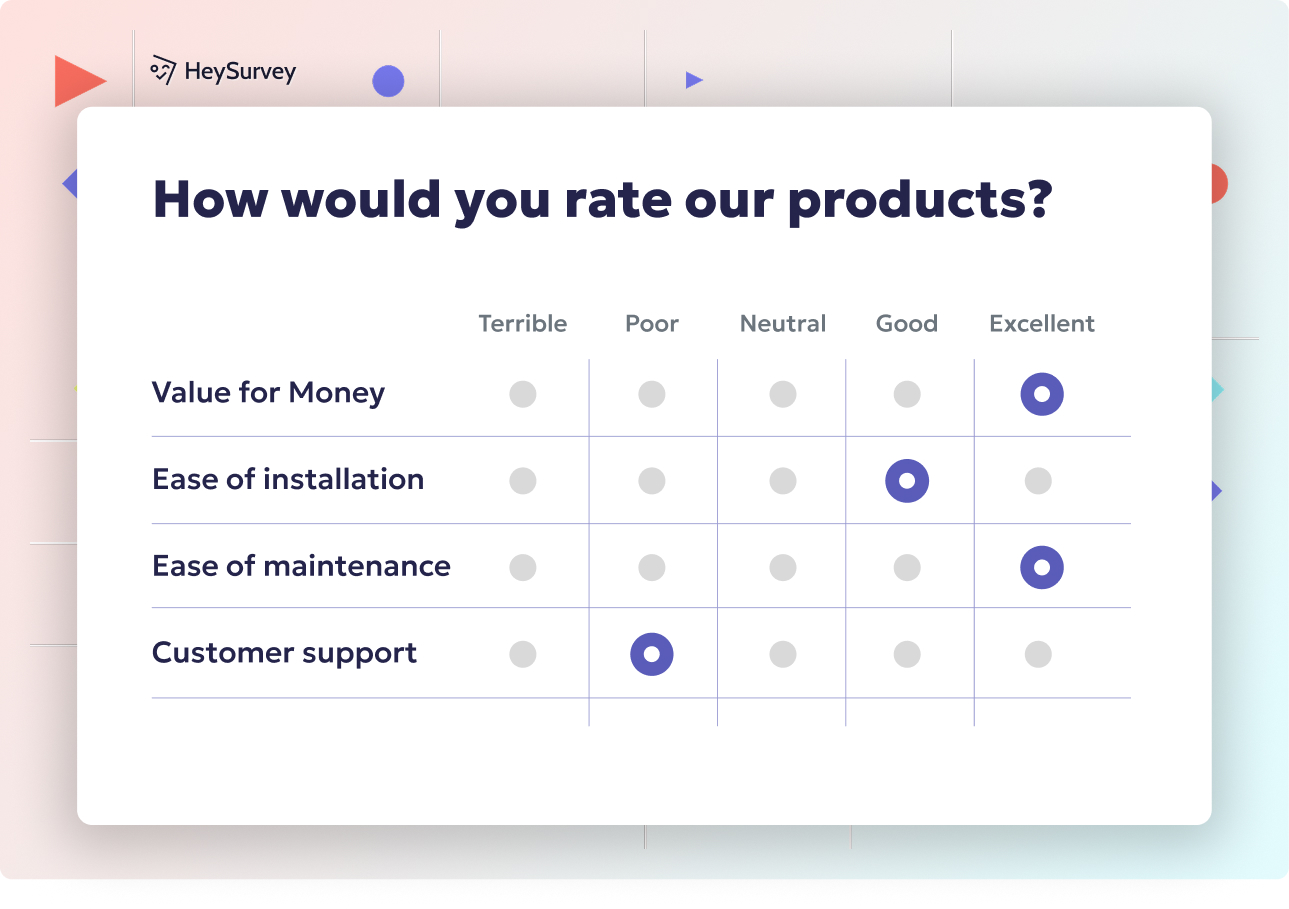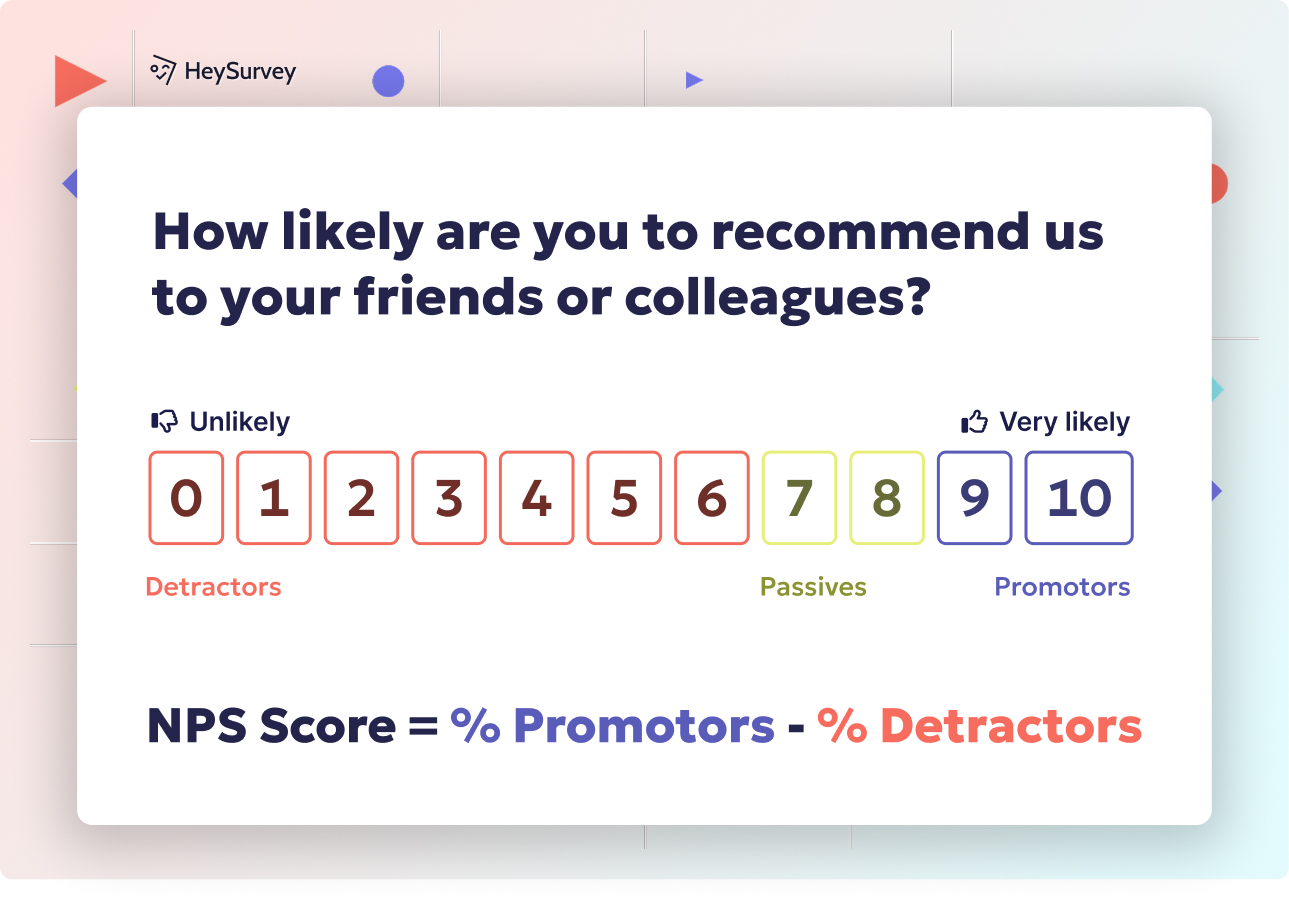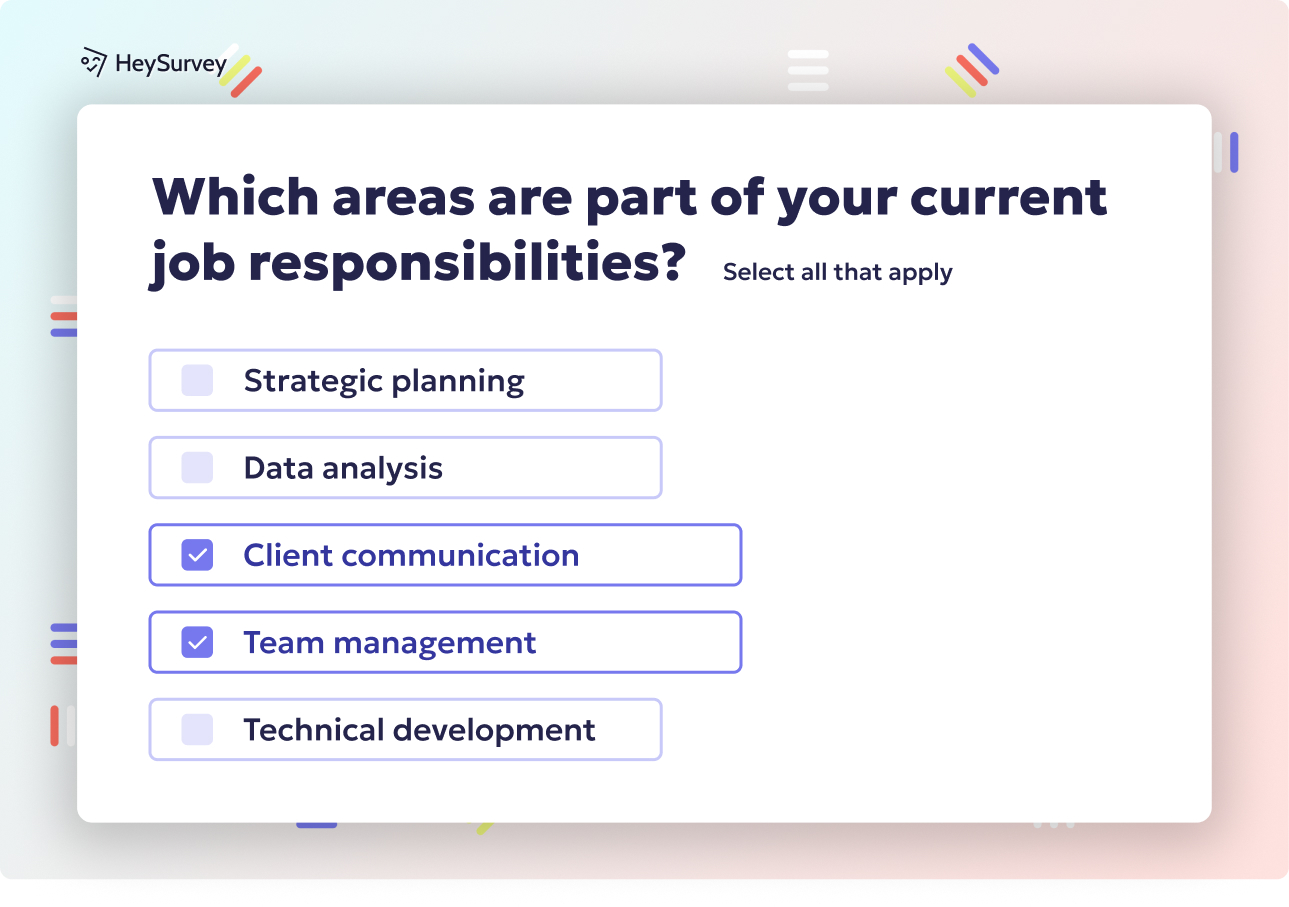32 Message Testing Survey Questions to Boost Your Brand Copy
Discover 28 expert message testing survey questions across 7 survey types to boost brand clarity, emotional impact, and copy performance.
Message testing survey questions are the secret sauce behind breakthrough marketing campaigns, sticky UX copy, and memorable brand launches. Smart brands never gamble on guessing their way into customers’ hearts—they run message testing surveys to see what rings true before doubling down on any words. Data-backed messaging is what fuels higher conversions, stronger brand recall, and headlines your audience can’t ignore. Whether you're rolling out a new campaign, giving your brand a facelift, puzzled by poor CTR, or trying to fix a lousy NPS, message testing isn’t just nerdy—it's necessary. Stick around and in the next sections, you’ll unlock seven proven survey types, sharp example questions, and clever best-practice tips to power your copy to the next level.
Concept Clarity Survey
Why & When to Use
A concept clarity survey is where it all begins. Before investing time and budget into splashy creative work, you have to know if your idea is coming through loud and clear. There's nothing worse than an audience staring at your landing page, squinting, and sighing, “Wait, what is this supposed to be?” These surveys dig into how your core message lands—perfect for early-stage ideas, MVPs, and new product launches.
Here’s the deal: you don’t want to tweak headlines or run a campaign for something no one understands. Whenever you have a hunch that your big idea is a bit fuzzy, or you’re headed into a pitch with lots of jargon, pause and run a concept clarity survey. Catch confusion now, before it snowballs into wasted budgets and missed goals.
Clarity is a huge booster for confidence, both inside your team and with your audience. When everyone interprets the concept the same way, your project has real legs.
5 Sample Questions
- In your own words, what is this product/service offering?
- How clear is the main idea on a scale of 1-7?
- What, if anything, is confusing about this description?
- Which words or phrases feel unclear or technical?
- After reading, how confident are you that you could explain this to a friend?
How It Works
The treasure in concept testing lies in those open-text answers. When you see ten different interpretations where you expected one, it's time for a rewrite. If your survey results come back with answers that echo your pitch deck, pat yourself on the back—you nailed it.
These “interpretation questions” are your safety net, catching hazy messaging before it tumbles out into the public eye.
Effective concept testing surveys should use clear, concise, and neutral language to ensure accurate and unbiased respondent feedback. (atom.com)

Creating your own message testing survey with HeySurvey is as simple as 1-2-3! Even if you’re new to the platform, the process is quick and intuitive. Ready? Let’s dive in.
Step 1: Create a New Survey
Start by logging into HeySurvey or opening the platform as a guest. Click the “Create New Survey” button to begin.
You can either start from a blank survey or select a template tailored for message testing surveys. Templates give you a helpful head start with pre-structured questions and design—perfect for beginners!
Give your survey a clear internal name so you can find it easily later.
Step 2: Add Your Questions
Now, it’s time to build your questionnaire. Click “Add Question” to insert the types of questions you want, such as single or multiple choice, rating scales, or open-text answers.
- Use the toolbar to format question titles with bold or italics to highlight key points.
- Customize answer options, add images or descriptions as needed.
- Don’t forget to mark important questions as required, so respondents won’t skip them.
If you’re using a template, tweak the preloaded questions to fit your specific messaging and target audience.
Step 3: Publish Your Survey
Once all questions are added and reviewed, hit the “Preview” button to see exactly what your respondents will experience. Make any last-minute tweaks to wording or design.
When you’re happy, click “Publish.” You’ll get a shareable link to your survey that you can send out via email, embed on your website, or post on social media. Responses will start coming in immediately!
Bonus Step A: Apply Your Branding
Add your logo and customize the look and feel via the Designer Sidebar.
Choose colors and fonts that match your brand to create a cohesive experience.
This little touch builds trust and professionalism from the very first question.
Bonus Step B: Define Survey Settings
Head over to the Settings Panel to:
- Set start and end dates for survey participation.
- Limit the number of responses if needed.
- Add a redirect URL to guide users after completion.
- Choose if respondents can view overall results.
These options help control access and customize the respondent journey.
Bonus Step C: Skip Logic and Branching
Want to make your message testing ultra-responsive? Use branching to tailor follow-up questions based on previous answers.
For example, if a respondent says they don’t understand a phrase, route them to a clarifying question.
This keeps your survey concise and relevant, boosting response quality.
Ready to start? Click the button below to open a message testing survey template and see how easy it is to create your perfect survey with HeySurvey!
A/B Copy Preference Survey
Why & When to Use
Creative teams often get stuck debating two headlines until their coffee goes cold. An A/B message testing survey ends the tug-of-war by putting both choices to the real test: your readers. When engagement metrics are stuck, and you've rewritten the subject line fifty times, try a targeted copy comparison survey.
These are ideal for digital teams itching for an answer to “Which call-to-action is stronger?” or “Which subject line gets more clicks?” There’s no shame in letting your customers decide what’s more clickable or more promising.
This survey helps you sidestep the HiPPO (Highest Paid Person’s Opinion) problem and focus on real, actionable feedback instead.
5 Sample Questions
- Which headline is more attention-grabbing? (Show A & B)
- Which version makes you more likely to click?
- What single word influenced your choice most?
- How believable is each statement? (7-point scale)
- If neither appeals, tell us why.
How It Works
Send your two prime contenders into battle and let the audience crown the winner. The answers might surprise you—sometimes the simplest option takes the prize. Use the “why” feedback to tune up copy until every word earns its place.
Whether it's an email header or a homepage hero message, a few rounds of A/B message testing can spike your results in record time.
A study demonstrated that an "emotional guilt" framed SMS reminder reduced hospital no-show rates from 21.1% to 14.2%, highlighting the impact of message framing on behavior. (pmc.ncbi.nlm.nih.gov)
Value Proposition Strength Survey
Why & When to Use
Every brand claims to be the best, the fastest, the most magical. But what do customers actually believe? A value proposition survey puts your promised benefits to the test. It tells you which selling points hit hardest, where you stand out, and if your differentiators are holding up against rivals.
This type of benefit messaging research is gold ahead of a big launch, during times of intense competition, or simply to double-check if your best pitch is still resonating. If a competitor is moving in on your turf, or you sense your website’s “Why Us” copy is gathering dust, this is your wake-up call.
Clarity isn’t enough—you need confidence that your offer sounds not just good, but better.
5 Sample Questions
- Rank these benefits from most to least compelling.
- What unique advantage stands out to you?
- How likely are you to switch brands based on this promise?
- Which competitor offers something similar?
- What extra proof would make you believe this claim?
How It Works
By prioritizing your benefits, your audience reveals what really matters to them. Don’t be surprised if the “unique” point you thought was hot turns out to be lukewarm. Use the competitor question to peek into what else your customers are seeing out there.
A winning value proposition isn’t just about standing out—it’s about proving why your brand deserves their vote of confidence.
Tone & Voice Alignment Survey
Why & When to Use
Are you coming across as the savvy industry expert or as your customers’ quirky best friend? A brand voice survey makes sure your copy walks the talk and actually matches your brand’s personality. When you're rebranding, going after a new market, or just worried your copy sounds like a robot, it’s time for tone testing questions.
Even the best-written message fizzles if it feels out of character. Your tech startup shouldn’t sound like an investment banker—unless, of course, that’s the whole point! This survey keeps your composure on track, ensuring the message vibe matches your brand and audience.
By nailing tone and voice, you spark trust, loyalty, and a sense of “this brand just gets me.”
5 Sample Questions
- Which adjectives best describe the voice of this copy?
- Does the tone feel appropriate for a [industry] brand? (Yes/No, explain)
- How formal or casual does the message sound? (slider)
- What emotions does the wording evoke?
- Which phrase feels out of character, if any?
How It Works
Let the audience do the labeling—if they’re picking words wildly different than your intended persona, there's a disconnect to fix. Track patterns in answers, especially adjectives and emotional cues.
Keep your brand voice sharp, consistent, and always aligned with what your community expects.
A 2024 survey found that 62% of consumers find a respectful brand tone engaging, while only 19% find an irreverent tone engaging. (atom.com)
Emotional Resonance Survey
Why & When to Use
Ever try to write the most heart-tugging ad ever, only for readers to shrug? Emotional message testing surveys help you gauge whether your message is sparking excitement, urgency, trust, or, unfortunately, nothing at all. They are clutch for storytelling campaigns, brand relaunches, and viral-hungry social ads.
You want to know: do people feel something when they read your words? Emotional connection is the shortest path to memorability and viral sharing. It can build loyal communities or shatter skepticism in seconds.
Emotions sell—period. But only if you’re pressing the right buttons.
5 Sample Questions
- What feeling best describes your reaction to this message?
- Rate how inspiring you find the copy (1-7).
- Which word triggers the strongest emotion?
- Does the message feel authentic or forced? Why?
- After reading, how likely are you to share it with others?
How It Works
Responses to sentiment survey questions show you what stirs your audience. You’ll quickly spot if something feels authentic, or if you’re accidentally coming off as try-hard. Use the sharing question to see if your message really sticks.
Tap into the right emotional current, and your campaign is halfway to viral.
Tagline & Slogan Recall Survey
Why & When to Use
Imagine spending months on a catchy tagline that nobody remembers. Ouch. Slogan testing saves you from this fate. These surveys measure not just memorability, but also whether your tagline is getting attributed correctly and standing out in a sea of sameness.
Deploy a tagline recall survey before unleashing your message on billboards or big-budget ads. You only get one chance to stick in someone’s mind at 70 mph on the freeway, so make every word count.
Originality rules here, but so does clarity—memorability is magic, not mystery.
5 Sample Questions
- Without looking back, type the slogan you just saw.
- How easy was it to remember? (1-7)
- Which brand do you associate with this tagline?
- What imagery comes to mind when you read it?
- How original does the slogan feel compared to competitors?
How It Works
Open-ended responses are your secret weapon. People will either echo your slogan exactly—or not. That’s your blueprint for revision. Combine recall scores with emotional and visual cues, and you’ll fine-tune a slogan that not only sings but sticks.
Visual-Message Congruence Survey
Why & When to Use
Words are nothing without the right pictures. If your visuals are all rainbows and your copy is all doom and gloom, you’ve got a branding problem. Visual and copy alignment surveys are your fix. They're essential for landing pages, social ads, packaging, and anywhere imagery and text must work hand-in-glove.
A mismatch can dull your message, dilute trust, or just confuse. Test your creative congruence before your campaign leaves the designer’s desk.
Visual-message congruence gives your customer that “ahh, it just fits!” feeling—that’s what makes brands stick.
5 Sample Questions
- How well do the visuals support the headline? (1-7)
- Which element feels off-brand: image or text?
- What single change would improve consistency?
- Does the photo make the promise more believable?
- After viewing, what key message do you recall?
How It Works
See which visual and copy combos get remembered—and which don’t. Use feedback to adjust your images or rewrite your text until they work together seamlessly. No more “what are they even selling?” moments. When your creative congruence is tight, every campaign element works in harmony.
Message Testing Best Practices
Dos
- Segment audiences to see how different groups react.
- Randomize order of messages to avoid bias.
- Keep stimuli short and focused for clean results.
- Mix qualitative and quantitative responses to capture both numbers and nuance.
- Pilot test first before rolling out the big survey.
Copy Testing Mistakes to Avoid
- Never lead respondents toward the answer you want.
- Don’t overload with jargon or insider terms.
- Avoid testing too many variables at once, or your results will get messy.
- Don’t ignore open-ended questions—they catch what stats can miss.
- Don’t ride on vanity metrics like likes and shares alone.
The best insights come from running iterative testing cycles—test, refine, and repeat. Always weave findings back into your creative process. Smart brands make message testing surveys a habit, not a one-off event.
By mastering these seven message testing survey types, you’ll sharpen every word, headline, and image until they work together like magic. Swipe these sample questions, keep best practices close, and watch your copy outshine the competition. When in doubt, let the audience be your guide—because the best message is the one they remember.
Related Market Survey Surveys

32 Market Research Survey Questions: Types, Samples & Tips
Explore 30+ market research survey questions with examples across types like CSAT, concept testin...

30 Coffee Survey Questions: The Complete Guide for Cafés & Brands
Discover 25+ expert coffee survey questions to boost cafés, product development, and brand insigh...

31 Content Marketing Survey Questions for Actionable Insights
Discover 25+ content marketing survey questions to gather actionable insights—boost audience alig...

